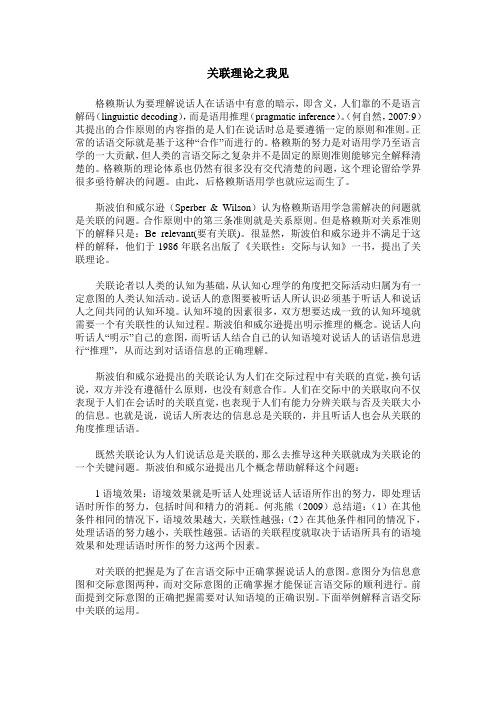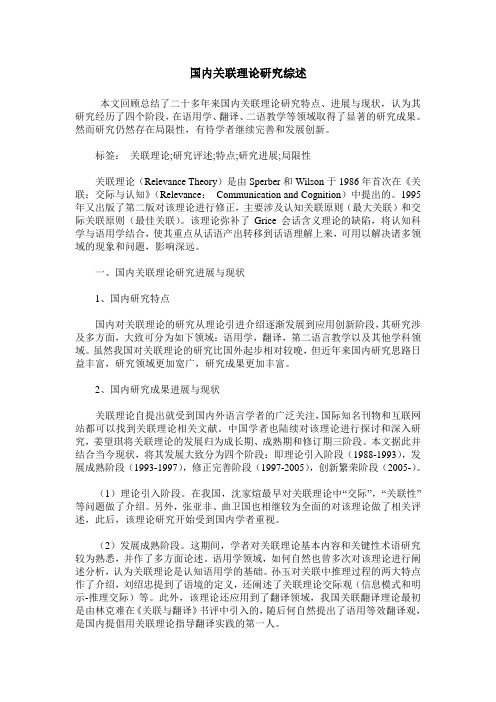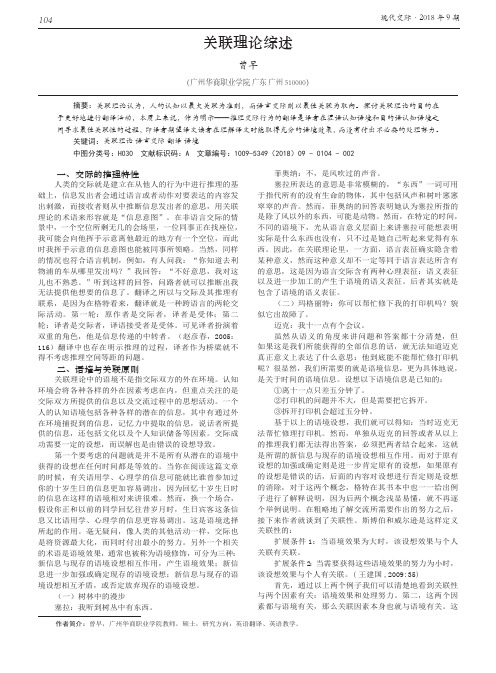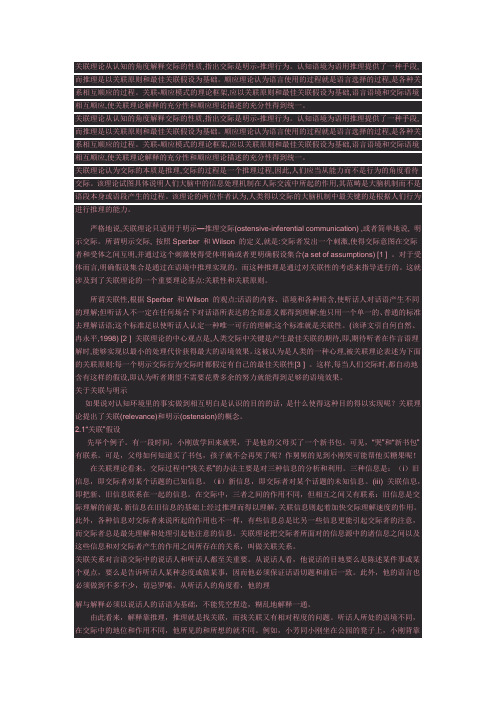关联理论总结
关联理论研究综述

关联理论研究综述【摘要】法国语言学家、哲学家Dan.Sperber 和英国语言学家Deirdre Wilson1986 年在《关联性:交际与认知》( Relevance:Communication and Cognition )中提出了关联理论。
本文就关联理论的主要观点以及关联理论的应用等方面对关联理论作一综述。
【关键词】关联理论;认知语境;最佳关联原则1、关联理论的主要观点1、1 关联理论的交际观。
Sperber 和Wilson 认为,语言交际是具有分裂性的,语言即使不用于交际中也可独立存在。
那么,真正涉及语言使用的活动并不是交际的而是认知的,语言是加工和记忆信息的基本工具。
她们认为,人类话语的理解、人类的故意交流决不仅仅是一个非智能的、机械的编码-解码过程,而是一种“明示-推理” 的过程。
因此,关联理论把交际定义为“明示-推理的行为” ,明示与说话人有关,推理主要与听话人有关。
刘绍忠在《关联理论的交际观》(1997)一文中对关联理论的交际观做了详细的介绍,并用唯物的、历史的和辩证的态度发表了自己的看法。
1、2 关联理论的认知语境。
关联理论的认知语境把语境看成是一个心理建构体,即存在于听话者大脑中的一系列可显映的事实或假设构成的集合。
认知语境包含着各种信息,主要由三种信息组成:词汇信息、百科信息和逻辑信息。
不同的人具有不同的认知语境,人们主要依靠“相互显映”和“互明”(即交际双方对认知语境中的事实或假设在心理上能作出共同的认知和推断)来达到相互交际、理解的目的。
关联理论的认知语境是一个动态语境,它把关联看作是常项,把语境看作变项,认知语境是在话语的理解过程中不断选择的结果,是听话人的一个重新构建的不断循环的过程。
认知语境除了动态性以外,房殿霞在《关联理论的认知语境观》(2006)中还提到认知语境还具有人本性、可选择性和完形性。
白彬、朱丽田在关联理论的语用价值分析中认为认知语境还具有即时性。
1、3 关联理论的语境效果。
《关联理论下汉英交传中显化策略研究》范文

《关联理论下汉英交传中显化策略研究》篇一一、引言在语言交流中,尤其是汉英交替传译过程中,如何有效传递信息、保证翻译的准确性和流畅性,一直是翻译研究的重点。
关联理论作为一种重要的认知语用学理论,为汉英交传中的显化策略提供了理论基础。
本文旨在探讨关联理论下汉英交传中显化策略的运用及其重要性。
二、关联理论概述关联理论是一种解释人类交际过程中如何推理出话语含义的认知语用学理论。
它认为,交际过程中的理解实际上是一个寻找关联的过程,即听话人根据说话人提供的语言信息及语境线索,寻找最恰当的关联,从而理解说话人的意图。
这一理论对于翻译过程具有重要指导意义。
三、汉英交传中的显化策略在汉英交传中,显化策略是指将原文中的隐含信息明确地表达出来,以降低听者的理解难度。
这种策略在跨文化、跨语言的交际中尤为重要。
在汉英交传中运用显化策略,有助于提高翻译的准确性和流畅性。
四、关联理论与显化策略的关联关联理论为汉英交传中的显化策略提供了理论依据。
在翻译过程中,译者需要寻找原文与译文之间的最佳关联,通过显化策略将原文中的隐含信息明确地表达出来,帮助听者更好地理解原文含义。
同时,显化策略的运用也需要考虑语境因素,以便找到最恰当的翻译方式。
五、显化策略在汉英交传中的应用1. 词汇显化:在翻译过程中,对于一些具有文化特色或抽象含义的词汇,可以通过添加解释性词语或短语,使其意义更加明确。
2. 句法显化:针对汉语中的一些特殊句式和结构,在翻译成英语时,可以通过调整语序、使用连接词等方式,使其更加符合英语的表达习惯。
3. 语境显化:在翻译过程中,充分考虑语境因素,通过添加背景信息、解释文化习俗等方式,帮助听者更好地理解原文含义。
六、实证研究本文通过实证研究方法,分析了汉英交传中显化策略的运用效果。
实验结果显示,运用显化策略的翻译在准确性和流畅性方面均优于未使用显化策略的翻译。
这表明显化策略在汉英交传中具有重要价值。
七、结论本文从关联理论的角度出发,探讨了汉英交传中显化策略的运用及其重要性。
关联理论总结

《翻译与关联——认知与语境》总结关联理论(Relevane Theory)最早是由Dan Sperber和Deirdre Wilson在《关联性:交际与认知》一书中提出来的,他们的学生Ernst-August Gutt根据关联理论对翻译进行了研究,并在五年后出版了《翻译与关联:认知与语境》(Translation and Relevace: Cognition and Context)。
格特在此书中率先将关联理论应用于翻译研究中,并指出翻译是一种言语交际行为,是与大脑机制密切联系的推理过程。
它不仅涉及语码,更重要的是根据动态的语境进行动态的推理,而推理所依据的就是关联性.作为交际的翻译,在对源语理解和翻译的过程中,人们对语码的选择所依赖的也是关联性.该书集中体现了格特的理论,他在关联理论的基础框架内探讨了翻译研究中颇具争议又引人注目的重要问题,既为翻译理论研究者深入清晰地阐述了观点,又为实践者提供了明确的指导。
该书一共有七章,在第一章开头的部分,格特首先引用Steiner,Levy,Kelly,Wilss等人的观点,指出当今翻译研究的现状是“mass of uncoordinated statements”,接着并给出了几点可能的原因;之后又对Hofmann,Wilss,Schulte 等人提出的“multidisciplinary scientific methodology research”这一新方案进行了批判,并进一步给出了当今翻译研究现状混乱不堪的三个根本原因:1. The risk of (multidisciplinary) disintegration.There is a question whether a comprehensive account of translation in the form of a coherent and homogeneous theory can ever be achieved。
关联理论的内容

关联理论的内容关联理论的内容(续写)。
在现实生活中,人们总是不断地发现新事物,也就是在这种发现新事物的过程中,创造出了一个又一个成功与辉煌的科技。
然而在我看来,更重要的是人类需要去探索未知的世界,正是由于这样才会有数学和物理等各种学科,从而使人类社会在不断进步的道路上飞速前进。
试想如果没有那些伟大的发明家们对自己所感兴趣领域的孜孜不倦地研究,就不会有电灯、汽车等许多种交通工具的诞生。
即使没有了他们,也不会有像牛顿、爱因斯坦等人所发现的微积分。
“满天下之忧而忧,后天下之乐而乐”的范仲淹曾用这句话来赞美古代的许多学者。
三十年河东,三十年河西。
让我们看一看现在吧!在二十世纪七十年代初期,当时人们普遍认为自行车是最方便的交通工具。
可是到了九十年代中期,随着经济的发展和人民生活水平的提高,自行车逐渐被汽车取代。
今天,尽管城市里有专门的自行车车道,但自行车的销售量却越来越少。
这不能不引起人们深思:为什么同样的产品在短短的几十年里竟会有这样的巨大变化呢?究其原因,不正是人们不断地去追求新的发明,不断地去开拓新的领域吗?由此可见,任何一种事物都不会永远存在,都将被别的事物所替代。
因此我认为,学习就好比是一条大河,我们要不断地去涉足每一个港湾。
今天的你就是明天的我;昨天的我就是今天的你。
每个人都在为自己的梦想而奋斗,希望的翅膀带动我们越飞越高,直到梦想的彼岸。
我们要去迎接下一个挑战,继续向前走,寻找下一个高峰。
在生活中,你的热情、好奇心,也许会给你带来意想不到的收获。
我认为只要大家不懈地努力,肯定会有惊喜等着我们。
面对未来的生活,人类有着无限的憧憬与幻想。
尤其是在未来的几十年里,人类科技发达,科技产品更是层出不穷。
当人们还沉浸在人造人的喜悦中时,智能机器人早已悄悄来到了我们身边。
这真是神话般的故事啊!未来的世界太奇妙了!我相信人类在探索宇宙奥秘的征途上,一定会有更大的收获。
现在是二十一世纪,竞争日益激烈的今天,想要赢得胜利就要靠自己。
关联理论读后感

关联理论是一个解读语用学的新途径。
关联理论尝试不仅解决关于交际本质的哲学问题,还从心理层面解释了理解过程如何在听话人脑中展开的问题。
交际中的语码和推理1989年,心理学家Paul Grice在William James Lectures一书中提到,除语码模式之外,交际过程还存在另一种模式。
这也标志了现代语言学的起点。
语码模式根据传统的语码模式,交流包括一系列的符号,信息,已及联系他们二者的语码。
在言语交际过程中,信号就成了话语,信息指讲话者企图表达的思想,而语法可能就成了起到联系作用的语码。
这样看来,话语和其含意之间的是以一种简单粗暴的方式联系的,而理解话语也成了不需要动脑筋的解码过程。
推理模式Grice在Willian James Lectures中提出交际至少是部分的职能活动,它包含推理运动和想象过程。
Grice认为话语不仅仅是单纯符号的集合,同时也是讲话人所表达意义的根据,交际的目的也在听话人开始按这些证据进行推理时达成。
一个语段,就是经过语言学编码的话语证据,因此理解过程中需要进行解码。
但是进过语言学编码的意义只是理解话语含义的依据之一。
另一个理解的重要依据即听话人的语境假设,它可以从不同角度丰富话语的语言学意义。
在Grice提出的推理模式中,一个交流者若想要传递他的想法,他只需让听众了解他的这个意图。
换句话说,我们只能通过推理而不是解码来了解意图。
当我看到你拿出一把钥匙并走向大门,我会合情合理地推断出你想要去开门;当你指着我旁边的关闭的窗户,我推断你想要我去打开它。
虽然这些推理看似合情合理,但它们并不是唯一的可能。
推理的意图-识别模式的提出是有风险的。
Grice对于语用学的主要贡献就是提出了有别于语码论的另一种理论的基础。
初步认识推理模式之后,它的更深层的含义还有待进一步发掘。
一个非语码组成,可推理的交际的最清楚的例子就是非言语的交流,包括指出,拟态,以及其他形式的示意或展示。
Grice举例说明了言语交流中暗含的部分也同样与实际的推理有关。
关联理论_精品文档

关联理论引言:关联理论是社会学家菲利普·斯拉特在1954年提出的理论,它是研究社会关系与人际互动的基本概念之一。
关联理论指出,个人的行为和态度是由人际关系和社会交往所导致的,我们所处的社会环境会对我们的行为和态度产生影响。
本文将深入探讨关联理论的概念、原理以及在实际应用中的意义。
一、关联理论的概念关联理论的核心思想可以简述为“人以群分、物以类聚”。
它认为,个人与他人之间存在着一种紧密的联系和相互影响,我们的行为和态度受到我们所处的社会环境和人际关系的影响。
关联理论着眼于探究个体与集体之间的互动,强调了社会关系对于个人行为的影响力。
二、关联理论的原理1. 社会归属感关联理论指出,人们有一种强烈的归属感,他们渴望与他人建立联系,寻求认同感和社会支持。
社会归属感的满足对于人们的心理健康和幸福感至关重要。
通过与他人互动,我们可以获得情感支持、信息分享以及共同体验的机会。
2. 同质性原则关联理论认为,人们倾向于与与自己具有相似特征、背景和价值观的人建立关系。
这种同质性原则可以解释为何我们会选择与某些人相处,而对其他人则不感兴趣。
同质性原则指导着我们在建立人际关系和社交网络时的选择,这种选择会影响我们的行为和态度。
3. 符号互动主义关联理论中的另一个关键概念是符号互动主义。
符号互动主义强调了人们通过交流和符号引起的互动来构建自己的社会现实。
通过与其他人的交流和互动,我们不仅可以获取信息和知识,还能够建立和维护我们自己的身份和角色。
符号互动主义对于理解社会关系和人际互动的动态过程具有重要意义。
三、关联理论的实际应用1. 教育领域关联理论为教育领域提供了重要的指导。
教育者可以通过组织合作学习、小组活动和社交互动,帮助学生建立良好的人际关系和社交网络。
这不仅有助于学生获取知识和技能,还能够提高他们的学习动机和学习效果。
2. 组织管理关联理论对于组织管理也有很大的启示。
组织可以通过促进员工间的互动和合作,提高团队凝聚力和员工满意度。
关联理论之我见

关联理论之我见格赖斯认为要理解说话人在话语中有意的暗示,即含义,人们靠的不是语言解码(linguistic decoding),而是语用推理(pragmatic inference)。
(何自然,2007:9)其提出的合作原则的内容指的是人们在说话时总是要遵循一定的原则和准则。
正常的话语交际就是基于这种“合作”而进行的。
格赖斯的努力是对语用学乃至语言学的一大贡献,但人类的言语交际之复杂并不是固定的原则准则能够完全解释清楚的。
格赖斯的理论体系也仍然有很多没有交代清楚的问题,这个理论留给学界很多亟待解决的问题。
由此,后格赖斯语用学也就应运而生了。
斯波伯和威尔逊(Sperber & Wilson)认为格赖斯语用学急需解决的问题就是关联的问题。
合作原则中的第三条准则就是关系原则。
但是格赖斯对关系准则下的解释只是:Be relevant(要有关联)。
很显然,斯波伯和威尔逊并不满足于这样的解释,他们于1986年联名出版了《关联性:交际与认知》一书,提出了关联理论。
关联论者以人类的认知为基础,从认知心理学的角度把交际活动归属为有一定意图的人类认知活动。
说话人的意图要被听话人所认识必须基于听话人和说话人之间共同的认知环境。
认知环境的因素很多,双方想要达成一致的认知环境就需要一个有关联性的认知过程。
斯波伯和威尔逊提出明示推理的概念。
说话人向听话人“明示”自己的意图,而听话人结合自己的认知语境对说话人的话语信息进行“推理”,从而达到对话语信息的正确理解。
斯波伯和威尔逊提出的关联论认为人们在交际过程中有关联的直觉,换句话说,双方并没有遵循什么原则,也没有刻意合作。
人们在交际中的关联取向不仅表现于人们在会话时的关联直觉,也表现于人们有能力分辨关联与否及关联大小的信息。
也就是说,说话人所表达的信息总是关联的,并且听话人也会从关联的角度推理话语。
既然关联论认为人们说话总是关联的,那么去推导这种关联就成为关联论的一个关键问题。
关联理论研究综述

则就是省力 , 简而言之 , 是通过最少的努力和劳动获 得最 佳 的效果 。与此同时 , 获得最佳 的关联 , 要 必须要满足 两个基 本条件 : 第一 , 说话者 的语 言首先能够足以吸引听话人 的 注
重大 的影 响。同时 , 格赖斯提 出了“ 际的合作原则 ” 交 交 。“ 际 的合作原 则” 出 : 要 理解 说话 人 话语 的隐含 意 义 , 指 “ 靠 的是语用推 理 , 而语境 和交 际的一般原 则是 实行 语 用推 理
文献标识 码 : A
一
、
示一推理 ” 的过程 。然而 , 关联理论把交际行为看作是 明示
1关联 理论 丰富的哲学内涵 .
“ 关联理论是对言语交 际的哲 学思考 , 现 了深刻 的哲 体 学 思想 ” 梁文华 ,9 8 。他认 为关 联 理论 中的关 联具 有 ( 19 ) “ 客观性 ” 从本源上讲 , 联并不发 源于语 句 之中 , 。“ 关 它是 事 物间建立起来的关系 , 关联是 客观存在 的” 。关联理论还 具 有普遍联系性 。关联是客观存在 的 , 又是普遍 存在 的, 关 联理论 体现 了辩证唯物主义 的普遍联 系的观点 。事 物之 间 是 普遍 联系的 , 这种 普遍存 在的关 系反 映在人 们 言语 观上 必然存 在其普遍联系性 , 即关联 性。有人说 , 联是相 互联 关
语境还具有 即时性 。
3 关联理论 的最佳关 联原则 . 18 96年 ,pre 和 Wio S eb r s l n提 出 的关联原 则是 , 每一 个
3 关联 理论 是对 Gle . r 理论 的修 正与补充 c 16 9 7年 , 国语 言学 家格 赖斯 提 出 了会话 含 义 理论 , 美
的重要依据 , 关联理论正是在此基础上发展 而来 的。
关联理论Relevance Theory

关联理论Relevance Theory (Sperber & Wilson)(以下简称RT)的两条原则:认知原则(人类倾向于认知的最大关联性)和交际原则(任何一种明示,交际行为都应该假定其本身就具有最佳关联性)。
关联理论把人与人之间的交际看作是一种有意图,目的的活动,是一个明示-推理的认知过程。
语境假设的过程要进行推理,而推理是一种思辨过程。
大脑中的演绎系统就是大脑的中心加工系统本身,它根据不同的输入手段提供的信息进行加工,也就是综合获得的新、旧信息以及关联信息(即把新旧信息联系在一起的信息),作出推理;在言语交际中,说话人通过明示(ostensive)1行为向听话人展示自己的信息意图和交际意图,为推理提供必要的理据;听话人就根据对方的明示行为进行推理,而推理就是寻找关联。
Sperber和Wilson (1986: 158)提出的关联原则是:/每一个明示的交际行为都应设想为这个交际行为本身具备最佳的关联性。
0最佳的关联性来自最好的语境效果。
因此,人们对话语和语境的假设、思辨、推理越成功,话语内在的关联就越清楚,就可以无须付出太多的努力就能取得较好的语境效果,从而正确地理解话语,获得交际的成功。
概念复合理论(Concept Blending Theory,以下简称为CB),就是关于对言语交际过程中各心理空间相互映射并产生互动作用的系统性阐述,其宗旨就是试图揭示言语意义在线构建(on-line construction)空间复合理论是由Fauconnier & Turner (1994) (以下简称F &T)在心理空间(Fauconnier, 1985/1994)理论的基础上共同提出的,概念整合理论认为人类在进行认知操作时,总是在不停地构建四个心理空间:两个输入空间(input spaces)、一个类属空间(generic space)和一个复合空间或合成空间(blended space)。
国内关联理论研究综述

国内关联理论研究综述本文回顾总结了二十多年来国内关联理论研究特点、进展与现状,认为其研究经历了四个阶段,在语用学、翻译、二语教学等领域取得了显著的研究成果。
然而研究仍然存在局限性,有待学者继续完善和发展创新。
标签:关联理论;研究评述;特点;研究进展;局限性关联理论(Relevance Theory)是由Sperber和Wilson于1986年首次在《关联:交际与认知》(Relevance:Communication and Cognition)中提出的。
1995年又出版了第二版对该理论进行修正,主要涉及认知关联原则(最大关联)和交际关联原则(最佳关联)。
该理论弥补了Grice会话含义理论的缺陷,将认知科学与语用学结合,使其重点从话语产出转移到话语理解上来,可用以解决诸多领域的现象和问题,影响深远。
一、国内关联理论研究进展与现状1、国内研究特点国内对关联理论的研究从理论引进介绍逐渐发展到应用创新阶段,其研究涉及多方面,大致可分为如下领域:语用学,翻译,第二语言教学以及其他学科领域。
虽然我国对关联理论的研究比国外起步相对较晚,但近年来国内研究思路日益丰富,研究领域更加宽广,研究成果更加丰富。
2、国内研究成果进展与现状关联理论自提出就受到国内外语言学者的广泛关注,国际知名刊物和互联网站都可以找到关联理论相关文献。
中国学者也陆续对该理论进行探讨和深入研究,姜望琪将关联理论的发展归为成长期、成熟期和修订期三阶段。
本文据此并结合当今现状,将其发展大致分为四个阶段:即理论引入阶段(1988-1993),发展成熟阶段(1993-1997),修正完善阶段(1997-2005),创新繁荣阶段(2005-)。
(1)理论引入阶段。
在我国,沈家煊最早对关联理论中“交际”,“关联性”等问题做了介绍。
另外,张亚非、曲卫国也相继较为全面的对该理论做了相关评述,此后,该理论研究开始受到国内学者重视。
(2)发展成熟阶段。
这期间,学者对关联理论基本内容和关键性术语研究较为熟悉,并作了多方面论述。
“关联理论”

"关联理论"关联理论的总目标就是“发现植根于人们心理的可以对彼此之间如何实现交际进行解释的隐含机制”。
为什么交际双方各自的交际意图能被对方识别?为什么交际双方配合得如此自然,既能生成话语,又能识别与理解对方的话语?斯珀伯与威尔逊提供的答案是:第一,交际中说话就是为了让对方明白,所以要求“互明”;第二,交际是一个认知过程,交际双方之所以能够配合默契,明白对方话语的暗含信息,主要因为存在一个最佳的认知模式——关联性。
这就是说,要找到对方话语同语境假设之间的最佳关联,通过推理获取语境含意,最终取得语境效果,达到交际成功。
涉及语言交际中的话语理解,尤其是语用信息的认知推理。
从亚里士多德到现代符号学,所有的交际理论都以语码模式为基础,语言就是一种语码,它的存在使交际成为可能。
比如,英语、汉语就是两种不同的语码,其中声音与意义有关,意义也同声音密切联系,因此如果A想对B传递某种信息,A就需要根据大脑中储存的思维信息去搜寻与特定意义有关的声音,然后向B传递这种声音,于是B又从自己的思维信息中去搜寻与该特定声音联系的意义,这样B就获取了A的信息。
非言语交际足以证明,语码并不是交际的唯一必要因素。
语码从属于推理。
例如:甲:今天感觉怎么样?乙:(从桌上拿起一个药瓶,递给甲看)交际中的理解过程包含两个阶段:(a)解码,是根据符号提取信息,信息与符号之间的联系是通过语码实现的。
(b)推理,是利用语言知识、逻辑知识、百科知识,从前提关系中得出结论的过程。
Sperber & Wilson认为交际中的语码可为信息理解的第二个阶段——推理——提供各种假设与证据。
如果我们将交际视为一个识别说话人的信息意图的过程,那么最好把语言解码当成为理解过程提供信息输入这一阶段。
他们还认为,只利用关联原则就可以替代合作原则及其准则。
交际者的明示行为后面都存在意图。
意图分为两种:信息意图informative intention是提供交际内容的意图。
关联理论原则

关联理论原则
关联理论原则
_________________________
关联理论原则是一种理论,它认为,事件之间存在因果关系,当一个事件出现时,就会导致另一个事件的出现。
关联理论的基本思想是,“事件A的出现,会引发事件B的出现”。
这种理论的原则是:一个事件会导致另一个事件的发生,而这种导致关系又可以分为三类:正向关联、反向关联和无关联。
一、正向关联
正向关联是指,当一个事件A发生时,就会导致另一个事件B的发生。
例如,如果你每天学习,你的成绩就会提高。
这里的正向关联就是:你每天学习,就会提高你的成绩。
二、反向关联
反向关联是指,当一个事件A发生时,就会导致另一个事件B不发生。
例如,如果你不学习,你的成绩就会降低。
这里的反向关联就是:你不学习,就会降低你的成绩。
三、无关联
无关联是指,当一个事件A发生时,不会对另一个事件B产生影响。
例如,你喝水不会影响你的成绩。
这里的无关联就是:你喝水不会影响你的成绩。
四、应用
关联理论原则在日常生活中有很多应用,它可以帮助我们更好地理解周围的事物,并制定出更有效的行动方案。
例如,当我们想要提高成绩时,可以根据正向关联原则来制定学习行动方案;而当我们想要减少饮食量来减肥时,可以根据反向关联原则来制定饮食行动方案。
五、总结
总而言之,关联理论原则是一种有效的工作方法,它能够帮助我们更好地理解周围的事物,并更有效地实施行动方案。
由此可见,学习和运用关联理论原则是非常重要的,它能够帮助我们在日常生活中得到更好的结果。
关联理论综述

104现代交际·2018年9期关联理论综述曾早(广州华商职业学院 广东 广州 510000)摘要:关联理论认为,人的认知以最大关联为准则,而语言交际则以最佳关联为取向。
探讨关联理论的目的在于更好地进行翻译活动,本质上来说,作为明示——推理交际行为的翻译是译者在源语认知语境和目的语认知语境之间寻求最佳关联性的过程,即译者期望译文读者在理解译文时能取得充分的语境效果,而没有付出不必要的处理努力。
关键词:关联理论 语言交际 翻译 语境中图分类号:H030 文献标识码:A 文章编号:1009-5349(2018)09 - 0104 - 002一、交际的推理特性人类的交际就是建立在从他人的行为中进行推理的基础上,信息发出者会通过语言或者动作对要表达的内容发出刺激,而接收者则从中推断信息发出者的意思,用关联理论的术语来形容就是“信息意图”。
在非语言交际的情景中,一个空位所剩无几的会场里,一位同事正在找座位,我可能会向他挥手示意离他最近的地方有一个空位,而此时我挥手示意的信息意图也能被同事所领略。
当然,同样的情况也符合语言机制,例如,有人问我:“你知道去利物浦的车从哪里发出吗?”我回答:“不好意思,我对这儿也不熟悉。
”听到这样的回答,问路者就可以推断出我无法提供他想要的信息了。
翻译之所以与交际及其推理有联系,是因为在格特看来,翻译就是一种跨语言的两轮交际活动。
第一轮:原作者是交际者,译者是受体;第二轮:译者是交际者,译语接受者是受体。
可见译者扮演着双重的角色,他是信息传递的中转者。
(赵彦春,2005:116)翻译中也存在明示推理的过程,译者作为桥梁就不得不考虑推理空间等距的问题。
二、语境与关联原则关联理论中的语境不是指交际双方的外在环境。
认知环境会将各种各样的外在因素考虑在内,但重点关注的是交际双方所提供的信息以及交流过程中的思想活动。
一个人的认知语境包括各种各样的潜在的信息,其中有通过外在环境捕捉到的信息,记忆力中提取的信息,说话者所提供的信息,还包括文化以及个人知识储备等因素。
关联理论

源起
传统语言学将交际与语言互为定义,例如,所谓 交际就是“人与人之间交流信息、感情、思想、 态度、观点等的一种行为。”而对于这些内容 的交际主要是通过语言.通过语言进行交际称 为言语交际.
言语交际就是“两人或更多的人之间创造意义 的过程.” 而对于语言,语言学家普遍认为,语言 是受语法制约的用于交际的表述系统。基于这 种观点,似乎语言的基本特征是被用于交际,而 交际的基本特征是它包含了语言或代码的使用。
成熟期(1993-1997): 我国学者对关联理论的内容已基本熟悉,并意识到它大大 地拓宽了语用学的研究领域,认为关联理论就是认知语用 学的基础,并对其优缺点进行了探讨。孙玉介绍了关联理 论的推理并不是一般的逻辑推理,它的推理有两大特点: 不能展示性(non-demonstrative)和综合性(global);并总 结了推理的规则法。 之后,何自然指出关联理论是对 Grice 理论的修正与补充, 具有灵活性,并断言关联理论可以取代 Grice 会话合作原则。 刘绍忠阐述了关联理论的交际观,认为关联理论把交际上 升到哲学的位置以及从心理认知的视角解释交际活动。交 际能否成功主要看交际者对认知环境能否相互明白和相互 明示,最后进一步指出了关联理论交际观的优缺点及正确 看待关联理论的态度 。
( 5) 认为关联理论过于笼统,抽象,无法实际 操作,它无法像语用解释理论那样从微观上对 语言交际进行探索,包括具体的原则,规则, 甚至提出按部就班的推理程序和步骤; 而认为 话语处理时人们只需根据关联的交际原则与认 知原则,以关联为取向,同时可以发挥认识主 体的能动性.
(6) 部分学者认为,关联理论没有说清楚话语 解释结果必然与偶然的问题,而曲卫国和刘绍 忠认为,话语解释的结果在相关这一点上是必 然的.
从关联理论看话语语境对词项语义认知的效应

从关联理论看话语语境对词项语义认知的效应话语语境对词项语义认知的效应,是探讨影响词汇语义理解的一个重要研究话题。
关联理论是目前用于解释语义理解过程中语境对词汇语义认知的效应的最受欢迎的理论之一。
在这篇文章中,我们将介绍关联理论相关的研究结论,以及它对词汇语义认知的贡献。
关联理论的基本假设是语义理解是通过人在不同语境中积累的词语关联来实现的。
可以把它想象成一个网状的词语表,每个单词之间都存在着一定的联系,这些联系有可能来自语言使用环境、潜意识或其他外部事件。
比如,当一个人提到“狗”一词时,他的大脑就会自动将“狗”与类似的词语联系起来,比如“爱”、“训练”、“散步”等。
这些关联会帮助理解者更清晰准确地把握词语的意思。
研究发现,语境对词汇语义认知的效应是可以显著改善词汇理解的。
比如,一项研究表明,当使用者被提供一个简单的上下文时,他们更易于正确理解一个复杂概念性的词汇,而不是孤立地看待它们。
另一项实验也发现,语境对词汇的深度代理意义的理解影响也很明显,比如使用者可以通过上下文快速正确地理解“自由”一词的意义。
关联理论也被认为是一种解释词语多义性的有效方式。
有研究表明,语义理解过程中,不同语境会激活不同的词汇意义。
即使在一个上下文中,不同的读者也可以按照自身的语言使用习惯和经验,选择不同的词汇意义来理解文本信息。
可以说,语境对理解多义性词汇具有明显的调节作用。
总之,通过结合语境和个人的语言习惯,关联理论可以有效地改善词汇语义的理解。
它既可以帮助理解者更准确地把握词语的意思,也可以解释词语多义性,让读者可以根据自身的经验和语境更好地理解句子信息。
因此,关联理论在认知心理学和语言文字运用研究中一直备受重视,并且发挥着极其重要的作用。
关联理论

人类交际的目的就是要改变对方的认知,为此说 话人所提供的新信息或假设应该是新的,更重要 的是要能改变听话人的语境假设,即产生语境效 果,那么话语就具有关联性。语境效果是新信息 与旧信息、新假设与原有假设等之间相互作用的 结果,其实是形成一种新的语境。这一过程被称 为“语境化”(contextualization)。通过该过程,旧 的语境假设或旧信息不断得到修正、补充与优化 。
三 交际中的关联性、认知努力与语境效果
1交际中的关联性
A: Smitty doesn’t seem to have a girlfriend these days.
B: He’s been driving to New York every weekend. B的回答可能产生如下理解:
a. Smitty has a girlfriend in New York.
3明示–推理模式
Sperber & Wilson把交际视为一种明示-推理 过程(ostensive-inferential process)。明示 与推理是交际过程中的两个方面即说话人 的明示行为,听话人的推理。 甲:去不去广州? 乙:听说塞车了。
对话中乙明说了“听说塞车了”这一信息 ,使甲明白该信息,这就是乙的信息意图 。这也是一种明示行为。通过这种明示, 听话人就会从中推导出该话语的含意,即 说话人的交际意图:“不去广州,因为塞
语码模式认为,交际活动 仅仅是交际主体双方依据 所使用语言的句法规则和 语义规则进行编码与解码 ,这样交际的成功取决于 听话人解码的信息与说话 人编码的信息是否一致。 据此,交际很少涉及非语 言因素的影响。
关联理论简介

关联理论1.关联理论的形成莫里斯(Morris)把语用学看成是探讨语言符号与符号使用者关系的学科,格赖斯(Grice)、奥斯汀(Austin)等人认为符号信息和交际意图有关系,是由推理支撑的超符号关系。
斯波伯(Sperber)和威尔逊(Wilson)逐渐把语言超符号关系的研究引入了认知的轨道,于1986年出版了一本题为《关联性:交际与认知》(Relevance:CommunicationandCognition)的专著,提出了与交际和认知有关的关联理论(relevance theory),1995年,他们又推出了第二版。
它是近几年来在西方语用学界有较大影响的认知语用理论。
2.关联理论的两个原则第一个原则(认知原则):认为人们的认知倾向于同最大关联相吻合。
第二个原则(交际原则):交际行为都应该设想为它本身具有最佳关联。
认知作为一个心理术语,涉及人对信息的选择、接收、处理、理解和储存的能力和过程,关联则涉及到一个省力问题,就语言交际而言,处理最关联的信息是一个自动倾向,语用者总是能够或自然地在所得信息和此间支出的努力两者之间取得最佳平衡,从而获得最佳信息效应。
她们提出的关联理论就是基于这种生物心理性质的“经济原则”,把关联定义为认知关联(人的认知倾向于最大程度地增加关联)和交际关联(交际行为所传递的是最佳关联的假设)。
3.关联理论的观点关联理论认为,语言符号的运作或语言交际,从认知角度出发,把语境定义为“一个心理结构体”,它是受话者头脑中关于世界的一系列假设,不仅包括交际的具体环境和上下文的信息,还包括对未来的期待、总体文化概念以及受话者对说话人心智状态的判断等,这些都对话语的理解起重要作用。
在语言交际中,受话者对世界的假设以概念表征的形式储存在大脑中,构成用来处理新信息的认知语境。
关联理论认为,话语的关联程度依赖于语境效果和处理努力,语境效果与关联成正比,处理能力与关联成反比。
并将把处理努力理解为认知语言环境所消耗的脑力,关联性越强,话语就越直接,认知所消耗的脑力越小,给受话者带来的认知负荷就越越小;反之亦然。
关联理论

关联理论从认知的角度解释交际的性质,指出交际是明示-推理行为。
认知语境为语用推理提供了一种手段,而推理是以关联原则和最佳关联假设为基础。
顺应理论认为语言使用的过程就是语言选择的过程,是各种关系相互顺应的过程。
关联-顺应模式的理论框架,应以关联原则和最佳关联假设为基础,语言语境和交际语境相互顺应,使关联理论解释的充分性和顺应理论描述的充分性得到统一。
关联理论从认知的角度解释交际的性质,指出交际是明示-推理行为。
认知语境为语用推理提供了一种手段,而推理是以关联原则和最佳关联假设为基础。
顺应理论认为语言使用的过程就是语言选择的过程,是各种关系相互顺应的过程。
关联-顺应模式的理论框架,应以关联原则和最佳关联假设为基础,语言语境和交际语境相互顺应,使关联理论解释的充分性和顺应理论描述的充分性得到统一。
关联理论认为交际的本质是推理,交际的过程是一个推理过程,因此,人们应当从能力而不是行为的角度看待交际。
该理论试图具体说明人们大脑中的信息处理机制在人际交流中所起的作用,其范畴是大脑机制而不是语段本身或语段产生的过程。
该理论的两位作者认为,人类得以交际的大脑机制中最关键的是根据人们行为进行推理的能力。
严格地说,关联理论只适用于明示—推理交际(ostensive-inferential communication) ,或者简单地说, 明示交际。
所谓明示交际, 按照Sperber 和Wilson 的定义,就是:交际者发出一个刺激,使得交际意图在交际者和受体之间互明,并通过这个刺激使得受体明确或者更明确假设集合(a set of assumptions) [1 ] 。
对于受体而言,明确假设集合是通过在语境中推理实现的。
而这种推理是通过对关联性的考虑来指导进行的。
这就涉及到了关联理论的一个重要理论基点:关联性和关联原则。
所谓关联性,根据Sperber 和Wilson 的观点:话语的内容、语境和各种暗含,使听话人对话语产生不同的理解;但听话人不一定在任何场合下对话语所表达的全部意义都得到理解;他只用一个单一的、普通的标准去理解话语;这个标准足以使听话人认定一种唯一可行的理解;这个标准就是关联性。
关联理论原则

关联理论原则
关联理论原则是指一种理论,主张一个事件的发生与另一个事件的发生之间存在关联。
如果有一个行为的发生,就会引起另一个行为的发生,他们之间存在一定的联系,人们会认为这两者之间存在关联,这就是关联理论的基本原则。
这一原则可以追溯到古希腊,由亚山大发展起来。
他以温馨的比较指出,一些事件可以被认为是相关联的,比如,烹饪与可食用食物之间的联系,雨水与大海之间的联系,以及鳐鱼与海洋之间的联系。
他也指出,一些事件之间可能存在一定的关联,而这种关联可能不易观察到。
今天,这一理论在社会学,心理学以及实验心理学中发挥着重要作用。
从人的行为来看,一件事会驱动另外一件事,并产生更大的影响。
比如,一个人看到一只狗后可能会开始渴望拥有一只自己的狗,这样会对他的行为产生更大的影响,比如去寻找合适的狗,然后去买狗,最后养活它。
这就是关联理论原则在行为学中发挥作用的示例。
关联理论也广泛应用于商业和广告领域。
其基本思想是,将一种产品与一项服务或一个品牌之间建立起联系,这样就能够增强消费者对这些产品的认知度,从而增加销售额。
比如,当美国大型商超公司Target在电视广告中联合某些品牌,比如可口可乐,消费者可能会联想到这家公司,而不是联想到可口可乐。
总而言之,关联理论原则是指一种认为一个事件的发生可以导致另一个事件的理论。
它成功地应用于许多领域,包括社会学、心理学、
实验心理学和商业广告,从而发挥着重要的作用。
它的运用有助于人们理解事物之间的联系,从而使他们能够更好地预测行为,并从中受益。
- 1、下载文档前请自行甄别文档内容的完整性,平台不提供额外的编辑、内容补充、找答案等附加服务。
- 2、"仅部分预览"的文档,不可在线预览部分如存在完整性等问题,可反馈申请退款(可完整预览的文档不适用该条件!)。
- 3、如文档侵犯您的权益,请联系客服反馈,我们会尽快为您处理(人工客服工作时间:9:00-18:30)。
《翻译与关联——认知与语境》总结关联理论(Relevane Theory)最早是由Dan Sperber和Deirdre Wilson在《关联性:交际与认知》一书中提出来的,他们的学生Ernst-August Gutt根据关联理论对翻译进行了研究,并在五年后出版了《翻译与关联:认知与语境》(Translation and Relevace: Cognition and Context)。
格特在此书中率先将关联理论应用于翻译研究中,并指出翻译是一种言语交际行为,是与大脑机制密切联系的推理过程。
它不仅涉及语码,更重要的是根据动态的语境进行动态的推理,而推理所依据的就是关联性。
作为交际的翻译,在对源语理解和翻译的过程中,人们对语码的选择所依赖的也是关联性。
该书集中体现了格特的理论,他在关联理论的基础框架内探讨了翻译研究中颇具争议又引人注目的重要问题,既为翻译理论研究者深入清晰地阐述了观点,又为实践者提供了明确的指导。
该书一共有七章,在第一章开头的部分,格特首先引用Steiner,Levy,Kelly,Wilss等人的观点,指出当今翻译研究的现状是“mass of uncoordinated statements”,接着并给出了几点可能的原因;之后又对Hofmann,Wilss,Schulte 等人提出的“multidisciplinary scientific methodology research”这一新方案进行了批判,并进一步给出了当今翻译研究现状混乱不堪的三个根本原因:1. The risk of (multidisciplinary) disintegration. There is a question whether a comprehensive account of translation in the form of a coherent and homogeneous theory can ever be achieved. 2. The problem of determining the domain of the theory. Krings (1986) comments that the notion of translation is used to refer to a variety of rather different phenomena. There have been three major lines of approach to this issue: shared intuitions; definition; culture-oriented——但是这三种方法均存在明显的缺陷。
紧接着,格特又批判了Toury 的观点:“the overall CONCEPT OF TRANSLATION underlying the corpus”。
因为这一观点的结果是:the culture-specific approach does not really resolve the problem of defining the theoretical domain: either it leads to the abolition of the intercultural study of translation or it does in fact rely on non-culture-specific criteria for determining its domain.3. The problem of evalution and decision-making. 此处,格特还批判了Steiner,Newmark等人的观点,同时还挑战了Nida 的对等理论。
另外,作者提出了两个问题:1)the problem ofover-specification. 以Wilss的理论为批判对象;2)Is ‘equivalence’an evaluate cocept? 主要针对House 的理论进行批判。
之后,作者又对科学翻译思想进行论述,分别从结果论和过程论进行说明,并指出了它们的不足。
最后,格特提出了:changes in scientific method.这里主要包括两个主要转变:1. A shift in the domain of the theory:翻译是一种与大脑机智密切联系的推理过程。
2. A shift from description to explanation:关联理论采用的不是描述分类法。
之后并引出了他自己的观点:Translantion as communication? 翻译是一种言语交际行为。
在第二章中,格特首先介绍了关于关联理论的一些基本概念,如“交际的推理本质”(The inferential nature of translation),交际者的“信息意图”(informative intention),交际中的明示程度,通过推理提供“交际线索”(Communicative clues)的“语义表达”(Semantic representations),从而指出交际是一种明示推理的过程。
紧接着他又详细地介绍关联理论中最重要的“最佳关联”(Optimal relevance)和“关联原则”(Principle of relevance),最佳关联的目的就是使交际中的听话者花费最小的信息处理达到足够的或最大的语境效果:“The central claim of relevance theory is that human communication crucially creats an expectation of optiaml relevance, that is an expectation on the part of the hearer that his attempt at interpretation will yield adequate contextual effects at minimal processing cost.”之后格特又提出关联理论中的交际分为两种不同模式:描述性运用(descriptive use)和解释性运用(interpretive use),并重点介绍了“意义相似”(Interpretive resemblance)概念,并主要从以下三个方面进行阐释:1. Interpretive resemblance between propositional forms: “Since all propositional forms have logic properties, two propositional forms may have some logic properties in common. Accordingly, we can say that mental representations whose propositional forms share logic properties resemble each otherin virtue of these shared logic properties. Such resemblance between propositional forms is called interpretive resemblance. 2.Interpretive resemblance between thoughts and utterances: “Every utterance comes with a guarantees of faithfulness”- that is, in each case “the speaker guarantees that her utterance is a faithful enough interpretation of the thought she wants to communicate”.3. Interpretive resemblance between utterances:格特在此处主要通过例子说明原文的话语与译文的话语之间的相似。
最后,他指出“The main purpose of utterances is to convey the set of assumptions which the communicator intends to convey.”在第三章中,格特主要就翻译中出现的一种现象——译文与原文是否完全吻合对交际过程并不会产生很大的影响进行了一系列探讨,并在该部分中首先提出了有关“隐性翻译”(Covert translation)的新论点。
他认为只有在隐性翻译中才有可能达到功能对等,这也是他对翻译的根本界定,Covert translations “have direct language addressees, for whom this translated text is as immediatedly and ‘originally’ relevant as source text is for the source language addressees.”他还通过举例说明了功能对等在隐性翻译中的重要性。
接着格特又通过广告翻译的案例论述了翻译文本中的功能变化问题,指出文本的功能是变化的,进而推导出原文不是翻译的唯一标准。
最后,格特首先讨论了译文本身在译入语中发挥多大的作用更重要,我们不能以与原文内容的近似性为评价译文好坏的标准,总结出“there is no necessary relationship between the source language and the target-language texts.”然后他又仔细区分了描述性运用和解释性运用的不同,并且解释了为什么有些翻译看起来不想翻译等问题。
在第四章中,格特主要对译文必须要保留原文语义的观点进行了建设性探讨。
他首先介绍了比较传统的翻译目标是要达到意义上的对等,并介绍了奈达和泰伯提出的“动态对等”(Dynamic equivalence)理论:强调译文读者对译文的反应要跟原文读者对原文的反应达到对等,因此强调译文要表达出原文的“meaning”而不是注重“form”;然后他又介绍了Beekman和Callow提出的“地道翻译方法”(Idiomatic translation approach),以及Larson对该方法的进一步发展,之后并用France的观点来反驳上述观点;接着,他在探讨有关次级交流环境问题的过程中,又批判了“动态对等”理论和“地道翻译方法”;最后,他便提出了自己的观点:Translating the same “message” by interpretive use?并讨论这个观点存在的一些问题,以及关联理论是否能解决这个问题。
